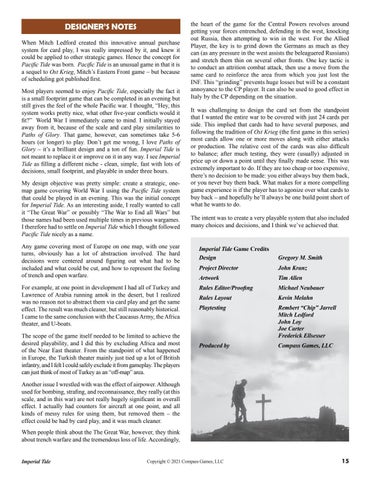DESIGNER’S NOTES When Mitch Ledford created this innovative annual purchase system for card play, I was really impressed by it, and knew it could be applied to other strategic games. Hence the concept for Pacific Tide was born. Pacific Tide is an unusual game in that it is a sequel to Ost Krieg, Mitch’s Eastern Front game – but because of scheduling got published first. Most players seemed to enjoy Pacific Tide, especially the fact it is a small footprint game that can be completed in an evening but still gives the feel of the whole Pacific war. I thought, “Hey, this system works pretty nice, what other five-year conflicts would it fit?” World War I immediately came to mind. I initially stayed away from it, because of the scale and card play similarities to Paths of Glory. That game, however, can sometimes take 5-6 hours (or longer) to play. Don’t get me wrong, I love Paths of Glory – it’s a brilliant design and a ton of fun. Imperial Tide is not meant to replace it or improve on it in any way. I see Imperial Tide as filling a different niche - clean, simple, fast with lots of decisions, small footprint, and playable in under three hours. My design objective was pretty simple: create a strategic, onemap game covering World War I using the Pacific Tide system that could be played in an evening. This was the initial concept for Imperial Tide. As an interesting aside, I really wanted to call it “The Great War” or possibly “The War to End all Wars” but those names had been used multiple times in previous wargames. I therefore had to settle on Imperial Tide which I thought followed Pacific Tide nicely as a name. Any game covering most of Europe on one map, with one year turns, obviously has a lot of abstraction involved. The hard decisions were centered around figuring out what had to be included and what could be cut, and how to represent the feeling of trench and open warfare. For example, at one point in development I had all of Turkey and Lawrence of Arabia running amok in the desert, but I realized was no reason not to abstract them via card play and get the same effect. The result was much cleaner, but still reasonably historical. I came to the same conclusion with the Caucasus Army, the Africa theater, and U-boats. The scope of the game itself needed to be limited to achieve the desired playability, and I did this by excluding Africa and most of the Near East theater. From the standpoint of what happened in Europe, the Turkish theater mainly just tied up a lot of British infantry, and I felt I could safely exclude it from gameplay. The players can just think of most of Turkey as an “off-map” area.
the heart of the game for the Central Powers revolves around getting your forces entrenched, defending in the west, knocking out Russia, then attempting to win in the west. For the Allied Player, the key is to grind down the Germans as much as they can (as any pressure in the west assists the beleaguered Russians) and stretch them thin on several other fronts. One key tactic is to conduct an attrition combat attack, then use a move from the same card to reinforce the area from which you just lost the INF. This “grinding” prevents huge losses but will be a constant annoyance to the CP player. It can also be used to good effect in Italy by the CP depending on the situation. It was challenging to design the card set from the standpoint that I wanted the entire war to be covered with just 24 cards per side. This implied that cards had to have several purposes, and following the tradition of Ost Krieg (the first game in this series) most cards allow one or more moves along with either attacks or production. The relative cost of the cards was also difficult to balance; after much testing, they were (usually) adjusted in price up or down a point until they finally made sense. This was extremely important to do. If they are too cheap or too expensive, there’s no decision to be made: you either always buy them back, or you never buy them back. What makes for a more compelling game experience is if the player has to agonize over what cards to buy back – and hopefully he’ll always be one build point short of what he wants to do. The intent was to create a very playable system that also included many choices and decisions, and I think we’ve achieved that.
Imperial Tide Game Credits Design
Gregory M. Smith
Project Director
John Kranz
Artwork Tim Allen Rules Editor/Proofing
Michael Neubauer
Rules Layout
Kevin Melahn
Playtesting Rembert “Chip” Jarrell Mitch Ledford John Loy Joe Carter Frederick Ellsesser Produced by
Compass Games, LLC
Another issue I wrestled with was the effect of airpower. Although used for bombing, strafing, and reconnaissance, they really (at this scale, and in this war) are not really hugely significant in overall effect. I actually had counters for aircraft at one point, and all kinds of messy rules for using them, but removed them – the effect could be had by card play, and it was much cleaner. When people think about the The Great War, however, they think about trench warfare and the tremendous loss of life. Accordingly, Imperial Tide
Copyright © 2021 Compass Games, LLC
15



